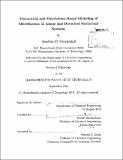| dc.contributor.advisor | Daniel Blankschtein. | en_US |
| dc.contributor.author | Mendenhall, Jonathan David | en_US |
| dc.contributor.other | Massachusetts Institute of Technology. Department of Chemical Engineering. | en_US |
| dc.date.accessioned | 2013-05-29T19:49:40Z | |
| dc.date.available | 2013-05-29T19:49:40Z | |
| dc.date.copyright | 2012 | en_US |
| dc.date.issued | 2012 | en_US |
| dc.identifier.uri | http://hdl.handle.net/1721.1/79026 | |
| dc.description | Thesis (Ph. D.)--Massachusetts Institute of Technology, Dept. of Chemical Engineering, 2012. | en_US |
| dc.description | Cataloged from PDF version of thesis. | en_US |
| dc.description | Includes bibliographical references (p. 446-471). | en_US |
| dc.description.abstract | Surfactants are chemically-heterogeneous molecules possessing hydrophilic (head) and hydrophobic (tail) moieties. This dual nature of surfactants leads to interesting phase behavior in aqueous solution as a function of surfactant concentration, including: (i) formation of surfactant monolayers at surfaces and interfaces, and (ii) self-assembly into finite aggregates (micelles) in the bulk solution beyond the critical micelle concentration (cmc). This concentration-dependent phase behavior induces changes in solution properties. For example, the surface activity of surfactants can decrease the surface tension, and self-assembly in bulk solution can lead to changes in viscosity, equivalent conductivity, solubilization capacity, and other bulk properties. These effects make surfactants quite attractive and unique for use in product formulations, where they are utilized as detergents, dispersants, emulsifiers, solubilizers, surface and interfacial tension modifiers, and in other contexts. The specific chemical structure of the surfactant head and tail is essential in determining the overall performance properties of a surfactant in aqueous media. The surfactant tail drives the self-assembly process through the hydrophobic effect, while the surfactant head imparts a certain extent of solubility to the surfactant in aqueous solution through preferential interactions with the hydrogen-bonding network of water. The interplay between these two effects gives rise to the particular phase diagram of a surfactant, including the specific cmc at which micelles begin to form. In addition to serving as a quantitative indicator of micelle formation, the cmc represents a limit to surface monolayer formation, and hence to surface and interfacial tension reduction, because surfactant adsorption at interfaces remains approximately constant beyond the cmc. In addition, the cmc represents the onset of changes in bulk solution properties. This Thesis is concerned with the prediction of cmc's and other micellization properties for a variety of linear and branched surfactant chemical architectures which are commonly encountered in practice. Single-component surfactant solutions are investigated, in order to clarify the specific contributions of the surfactant head and tail to the free energy of micellization, a quantity which determines the cmc and all other aspects of micellization. First, a molecular-thermodynamic (MT) theory is presented which makes use of bulk-phase thermodynamics and a phenomenological thought process to describe the energetics related to the formation of a micelle from its constituent surfactant monomers. Second, a combined computer-simulation/molecular-thermodynamic (CSMT) framework is discussed which provides a more detailed quantification of the hydrophobic effect using molecular dynamics simulations. A novel computational strategy to identify surfactant head and tail using an iterative dividing surface approach, along with simulated micelle results, is proposed. Force-field development for novel surfactant structures is also discussed. Third, a statistical-thermodynamic, single-chain, mean-field theory for linear and branched tail packing is formulated, which enables quantification of the specific energetic penalties related to confinement and constraint of surfactant tails within micelles. Finally, these theoretical and simulations-based strategies are used to predict the micellization behavior of 55 linear surfactants and 28 branched surfactants. Critical micelle concentration and optimal micelle properties are reported and compared with experiment, demonstrating good agreement across a range of surfactant head and tail types. In particular, the CSMT framework is found to provide improved agreement with experimental cmc's for the branched surfactants considered. | en_US |
| dc.description.statementofresponsibility | by Jonathan D. Mendenhall. | en_US |
| dc.format.extent | 471 p. | en_US |
| dc.language.iso | eng | en_US |
| dc.publisher | Massachusetts Institute of Technology | en_US |
| dc.rights | M.I.T. theses are protected by
copyright. They may be viewed from this source for any purpose, but
reproduction or distribution in any format is prohibited without written
permission. See provided URL for inquiries about permission. | en_US |
| dc.rights.uri | http://dspace.mit.edu/handle/1721.1/7582 | en_US |
| dc.subject | Chemical Engineering. | en_US |
| dc.title | Theoretical and simulations-based modeling of micellization in linear and branched surfactant systems | en_US |
| dc.type | Thesis | en_US |
| dc.description.degree | Ph.D. | en_US |
| dc.contributor.department | Massachusetts Institute of Technology. Department of Chemical Engineering | |
| dc.identifier.oclc | 841274550 | en_US |
